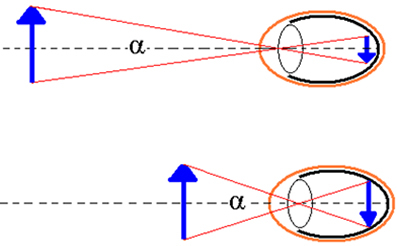As we know, the normal human eye can focus on very distant objects and objects that are up to 25 cm from the eye, varying the focal length of the lens. The size of the object and the distance it is from the viewer determines the size of the image that forms on the retina.
The figure above shows us a simple example, which we see in everyday life, of the relativity of the image size of different objects located at different distances. Although the Moon is much larger than the trees, these appear larger than the Moon because they are closer to the observer. This fact can be understood using the concept of angle of view.
We define the angle of view as the angle between two lines that leave the eye and go to the edges of the object.
See the figure below. The observer at position 1 sees the image of the box smaller than position 2 when approaching the object.

To better understand how the viewing angle α is related to the size of the image on the retina, let's sketch how the eye sees an image. The figure below shows the image formation of an object on our retina. Note that the size of the retinal image is proportional to the angle of view
α and inversely proportional to the object's distance.When the object is closer, both the angle of view α and the retinal image are larger than when the object is far away.

The viewing angle increases as we approach the object. Therefore, closer objects appear larger. The two observers shown in the figure above see the same object with different sizes because the viewing angles are different.
The viewing angle is also defined as the maximum angle at which we have totally free vision. When looking through a window, our angle of view is limited by the width of the window. The same effect occurs when looking at an object using a plane mirror.
The closer we are to the mirror, the greater the viewing angle. This concept is useful when designing rear view mirrors for automobiles. A small rearview mirror away from the driver provides a smaller viewing angle than a larger mirror closer to the driver.
By Domitiano Marques
Graduated in Physics
Source: Brazil School - https://brasilescola.uol.com.br/fisica/tamanho-imagem-campo-visao.htm
